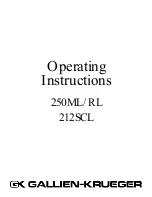
Orchestra Level
V-Accordion
r
49
This parameter allows you to specify
how the FR-1x should respond to the
bellows’ movements. Use it to adapt the
FR-1x’s expressive potential to your playing style.
The available options are:
■
Fixed Low, Fixed Medium, Fixed High
These three fixed curves always use the same expres-
sion value, no matter how hard or lightly you push/
pull the bellows (no dynamic control). “Low” means
that a low value is used, “Med” represents a medium
value and “High” a high value.
■
X Light, Light
“Light” means that you do not need to push/pull hard
to achieve a meaningful effect. The “X-Light” requires
even less strength (the “X” stands for “extra”).
■
Standard
The “Standard” curve refers to a normal response.
■
Heavy and X Heavy
“Heavy” provides a greater variety of nuances.
“X-Heavy” is even more detailed.
Much care has been taken to provide a
natural stereo image for the accordion
sounds. If you think the stereo image is
too wide for comfort (or if you prefer to set the Pan
controls on your mixing console differently), you can
use this parameter to reduce the stereo image.
“
Ful
” (full) represents the widest stereo image.
“
Nat
” (natural) means that the original stereo image is
used.
“
–63
” corresponds to an extremely narrow stereo
image.
All other values represent slight (or increasingly drastic)
reductions of the stereo width.
Treble Mode (only on the button type)
Like for the accordion instrument itself,
there are different varieties of chromatic
instruments, with different treble button
layouts.
The available options are:
Since your FR-1x is an electronic musical instrument,
changing the note assignments to the buttons is a mat-
ter of selecting the preset that best suits your playing
style. You’ll probably only change this setting once. But
it’s nice to know that it exists in case you let a fellow
accordion player from another country play your FR-1x.
Please look at the illustrations on pages 50 and 51 to
identify the setting you need. Pay attention to the note
names (all Cs appear on a grey background) and look at
how they are arranged, then make your selection. The
numbers next to the letters refer to the octave. The
numbers below the note names represent the corre-
sponding MIDI note numbers.
You may have noticed that the treble buttons are col-
ored white (for notes without alteration) and black
(notes with alteration, i.e.
#
/
b
). This coloring doesn’t
change when you select another system.
The FR-1x is supplied with additional white and black
buttons. You can use these additional buttons to adapt
the black and white treble buttons to reflect the
selected treble mode.
To do this, first remove the button you wish to replace
by turning it counterclockwise, then install the new
button and screw it clockwise.
NOTE
This parameter is not reset when you load the factory defaults
(page 64).
Value
1~8
Default setting: 6
Value
Setting
Value
Setting
1
Fixed Low
5
Light
2
Fixed Medium
6
Standard
3
Fixed High
7
Heavy
4
X Light
8
X Heavy
Value
–63~–1, Nat, Ful
Default setting:
Nat
blC
StE
Value
1~6
Default setting:
1
Value
Setting
Value
Setting
1
C-Griff Europe
4
B-Griff Fin
2
C-Griff 2
5
D-Griff 1
3
B-Griff Bajan
6
D-Griff 2
trM
FR-1x GB.book Page 49 Tuesday, November 8, 2011 11:44 AM
















































